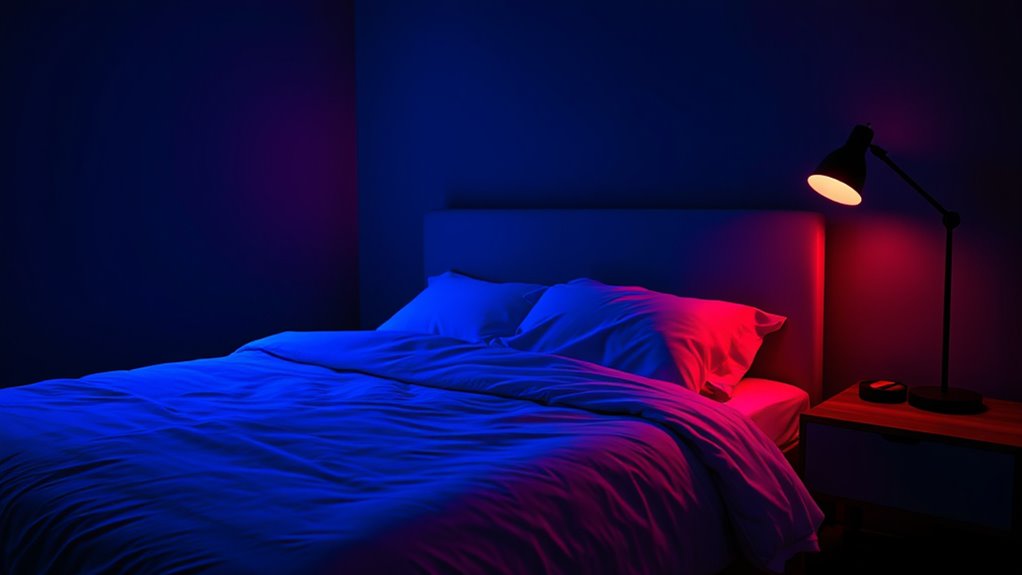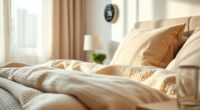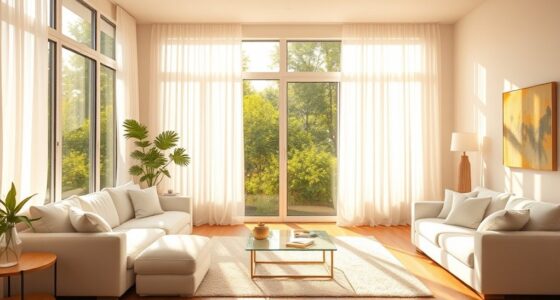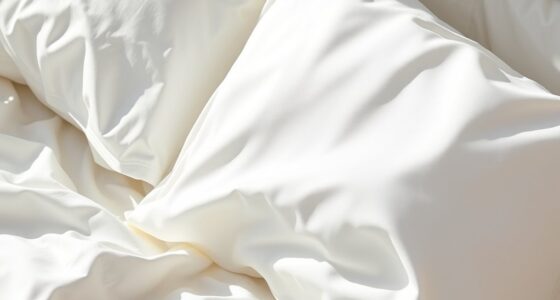Blue light from screens messes with your internal clock by suppressing melatonin, making it harder to fall asleep and disrupting your circadian rhythm. Red light, on the other hand, minimally interferes with melatonin, helping you wind down naturally. Using warm, dim lighting or red filters in the evening supports better sleep, while minimizing blue light exposure. If you want to discover more about how color can improve your rest, keep exploring this fascinating topic.
Key Takeaways
- Blue light suppresses melatonin production, delaying sleep onset and disrupting circadian rhythms, especially when used in the evening.
- Red light minimally impacts melatonin, supporting natural sleep cycles and promoting deeper, more restorative sleep.
- Exposure to warm, red hues in the evening can create a calming environment that aids in winding down before sleep.
- Bright, cool blue lights during night hours can cause overstimulation, making it harder to fall asleep and reducing sleep quality.
- Future innovations include adaptive lighting systems that optimize color exposure to enhance sleep health and circadian alignment.
How Blue Light Disrupts Your Body’s Internal Clock
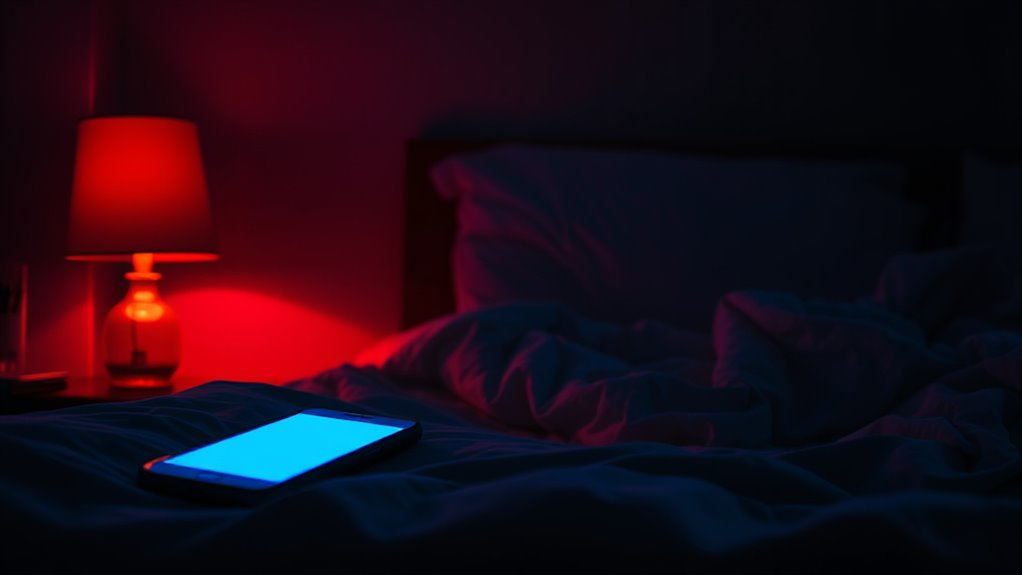
Blue light from screens and artificial sources can considerably disrupt your body’s internal clock, also known as the circadian rhythm. When you’re exposed to blue light late in the day, it signals your brain to stay alert, delaying melatonin production, which is essential for sleep. This disturbance can throw off your natural sleep-wake cycle, making it harder to fall asleep and wake up refreshed. To counteract this, consider using light therapy devices that emit safer, controlled light levels during the day to strengthen your circadian rhythms. Reducing blue light exposure in the evening helps your internal clock stay aligned, promoting better sleep quality. Being mindful of your light environment is key to maintaining a healthy sleep pattern and overall well-being.
The Surprising Effects of Red Light on Melatonin Production
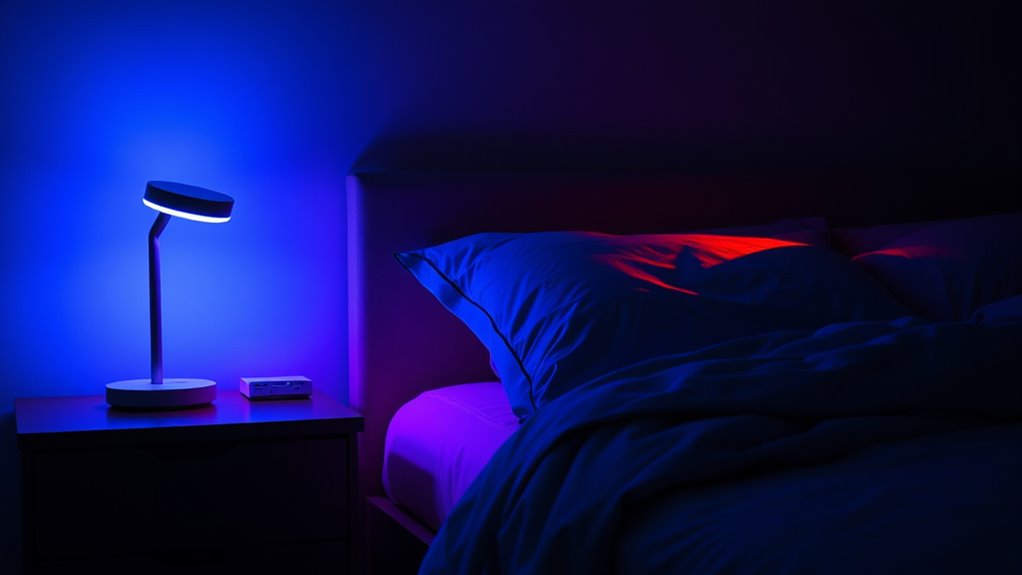
Red light can help reduce melatonin suppression, making it easier for you to fall asleep. It may also improve your overall sleep quality by supporting your body’s natural rhythms. Your brain responds differently to red light, which could be key to better rest. Additionally, understanding how AI safety measures are developed can inform the ways we design lighting environments that promote healthier sleep patterns.
Melatonin Suppression Reduction
While many lights can disrupt your sleep, red light has been found to have a surprisingly minimal impact on melatonin production. This makes it a valuable tool for maintaining your circadian rhythms, especially in the evening. Unlike blue or white light, red light doesn’t *considerably* suppress melatonin, allowing your body to prepare for sleep naturally. This is why some people use red light during light therapy or evening activities to avoid delaying sleep onset. By reducing melatonin suppression, red light helps keep your internal clock aligned, supporting overall sleep health. Additionally, red light’s low light pollution makes it ideal for urban environments, where artificial light is abundant. If you’re sensitive to light or want to minimize disruptions, incorporating red light into your nighttime routine can be an effective strategy to protect your melatonin levels and promote better sleep.
Enhanced Sleep Quality Potential
Because red light minimally suppresses melatonin, it not only helps preserve your circadian rhythm but may also enhance overall sleep quality. Using red light for light therapy before bed can create an environment conducive to restful sleep, supporting better sleep hygiene. Unlike blue light, red wavelengths don’t interfere with melatonin production, allowing your body to wind down naturally. Incorporating red light into your evening routine may reduce sleep disruptions and improve sleep duration. Consistent use of red light for pre-sleep activities can help regulate your sleep cycle and promote deeper, more restorative sleep. Additionally, understanding how cultural narratives influence sleep habits can help you tailor your environment for better rest. This simple adjustment offers a non-invasive way to optimize sleep quality without relying on medications, making it a practical addition to your overall sleep hygiene strategy.
Brain’s Light Response
The brain’s response to light is more complex than simply signaling day or night; it involves specialized pathways that influence hormone production, including melatonin. Light receptors in your eyes detect specific wavelengths, sending signals through neural pathways to the brain’s visual and hormonal centers. When exposed to red light, these receptors activate differently compared to blue light, resulting in less suppression of melatonin. This means your brain perceives red light as less disruptive, allowing melatonin levels to stay higher when you’re exposed during evening hours. The neural pathways connecting light receptors to the pineal gland help regulate this process. Understanding this response underscores why red light can be less disruptive to your sleep cycle than other colors, influencing your sleep quality more subtly than you might realize. Additionally, recent advancements in AI in Education are helping researchers analyze how various light wavelengths impact sleep patterns and overall health.
Screens and Sleep: Why Your Phone Might Be Sabotaging Rest

Using your phone before bed exposes you to blue light, which can interfere with melatonin production and make falling asleep harder. Evening screen time can delay your sleep cycle and reduce sleep quality. Luckily, there are simple strategies to protect your rest, like limiting screen use or using night mode. Incorporating air purifier technology can also help improve sleep environments by reducing airborne pollutants and allergens that may disturb rest.
Blue Light Disrupts Melatonin
Have you ever wondered why scrolling through your phone late at night leaves you feeling more awake? It’s because blue light, which has a specific light wavelength, interferes with your body’s natural sleep signals. This type of light disrupts melatonin production, the hormone responsible for making you feel sleepy. During the day, exposure to natural light helps regulate your circadian rhythm through color therapy, but at night, artificial blue light tricks your brain into thinking it’s still daytime. As a result, your body delays melatonin release, making it harder to fall asleep and reducing sleep quality. Additionally, color temperature adjustments can help optimize your viewing conditions and minimize sleep disruption. To protect your sleep, limit screen time before bed or use blue light filters, allowing your body’s natural sleep cycle to function properly.
Evening Screen Time Impact
Evening screen time can considerably harm your sleep quality, especially when you spend hours scrolling through your phone or tablet before bed. Blue light emitted by screens interferes with your body’s production of melatonin, the hormone that helps you feel sleepy. This disruption makes it harder to fall asleep quickly and reduces overall sleep quality. Your evening routines often include checking messages, social media, or streaming shows, all of which expose you to blue light. The longer you stay on screens before bed, the more your natural circadian rhythm gets thrown off. To protect your sleep, consider reducing screen exposure in the hour before bedtime. Establishing a relaxing evening routine free of screens can help your body prepare for restful sleep. Additionally, being aware of Forsale 100 products related to sleep improvement may offer helpful solutions.
Strategies to Protect Sleep
To safeguard your sleep, adopting specific strategies can make a significant difference in reducing blue light exposure and calming your mind before bed. Implementing good sleep hygiene, like turning off screens an hour before sleep, helps limit blue light’s impact. Using light therapy in the morning can boost alertness and regulate your circadian rhythm. Consider blue light filters or glasses in the evening to block harmful wavelengths. Creating a relaxing pre-sleep routine also signals your body it’s time to wind down.
| Strategy | Benefit |
|---|---|
| Use blue light filters or glasses | Reduces blue light exposure |
| Incorporate light therapy | Reinforces natural sleep-wake cycle |
| Maintain consistent sleep schedule | Improves sleep quality |
| Practice relaxing activities | Eases your mind and promotes rest |
The Science Behind Color and Sleep Cycles
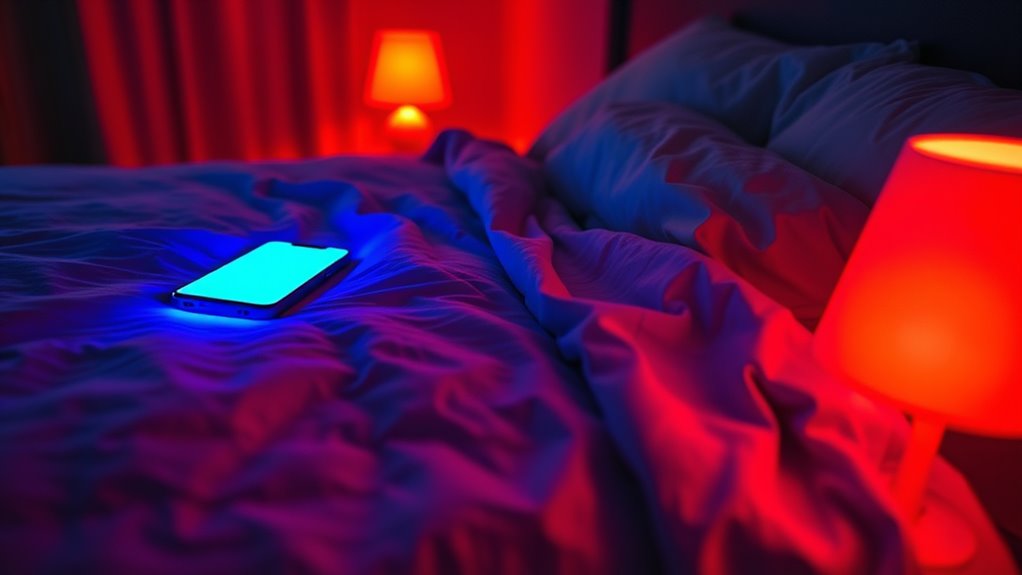
The colors around you can directly influence your sleep cycles by affecting your brain’s production of melatonin, the hormone responsible for regulating sleep. Research in color psychology shows that different hues send signals to your brain, influencing alertness or relaxation. For instance, blue light suppresses melatonin more than red or warm tones, making it harder to fall asleep. Light therapy uses specific colors to reset or reinforce your circadian rhythm, helping improve sleep quality. When exposed to calming, warmer colors in the evening, your body receives signals that it’s time to wind down, supporting natural sleep patterns. Additionally, incorporating color psychology principles into your bedroom environment can enhance relaxation and promote better sleep. Understanding these mechanisms explains why certain colors, especially in your environment or screens, can disrupt or promote healthy sleep cycles.
Practical Tips for Managing Light Exposure at Night
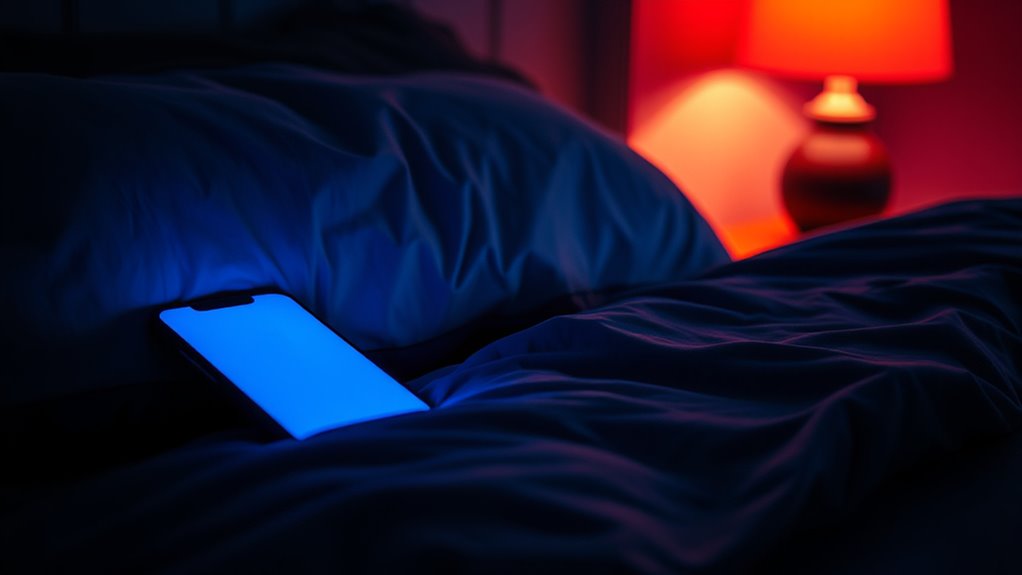
Managing your light exposure at night can substantially improve your sleep quality by minimizing disruptions to your melatonin production. To do this, practice good sleep hygiene by limiting screen time before bed and using dim, warm-colored lights in the evening. Consider using blue light filters on devices or wearing blue light blocking glasses if you need to use screens. Implementing light therapy in the morning can help reset your circadian rhythm, making it easier to fall asleep at night. Avoid bright, cool-colored lighting late in the day to reduce melatonin suppression. Creating a consistent evening routine that minimizes exposure to stimulating or harsh lights helps your body recognize when it’s time to wind down, promoting healthier sleep patterns overall. Additionally, incorporating eye patches into your self-care routine can help reduce eye strain and refresh your eyes after long screen sessions, further supporting your overall well-being.
The Role of Ambient Lighting in Creating a Sleep-Friendly Environment

Ambient lighting plays a essential role in shaping a sleep-friendly environment because it influences how your body perceives relaxation and readiness for sleep. Thoughtfully chosen lighting aesthetics can create a calming atmosphere, making your space more conducive to rest. Incorporating warm, dim lights aligns with good interior design principles and signals to your brain that it’s time to wind down. The right ambient lighting reduces overstimulation and helps regulate your circadian rhythms. Consider the following table to understand how different lighting choices impact sleep environment:
| Lighting Type | Effect on Sleep |
|---|---|
| Warm, dim lights | Promotes relaxation |
| Bright, cool lights | Disrupts melatonin production |
| Spotlights | Creates contrast, overstimulating |
| Soft lamps | Enhances cozy ambiance |
| Overhead fluorescents | Detracts from restful environment |
Additionally, selecting appropriate lighting can prevent interference with your body’s natural sleep signals.
Future Technologies and Strategies for Color-Optimized Sleep
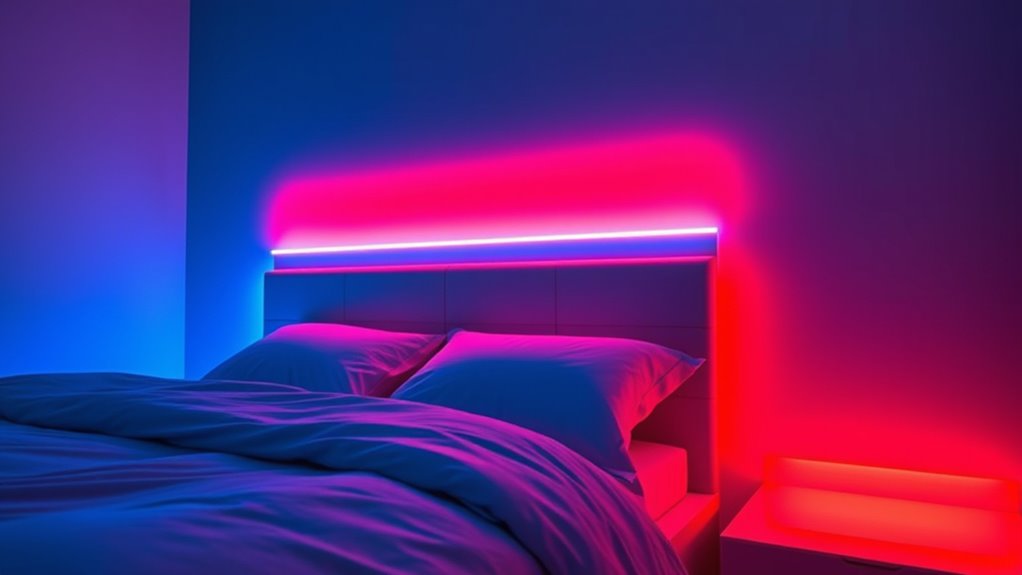
Advancements in technology are opening new possibilities for optimizing sleep through targeted color strategies. Light modulation devices are becoming more sophisticated, enabling personalized adjustments that align with your circadian rhythms. Future innovations may include sleep glasses or room lighting systems that adapt color therapy to your sleep stages, reducing exposure to disruptive blue light and enhancing melatonin production. Researchers are exploring smart textiles embedded with color-changing fibers that respond to your body’s signals, promoting relaxation and deeper sleep. These technologies aim to fine-tune your environment with dynamic, evidence-based color interventions. As a result, you’ll have more control over your sleep quality, using precise light modulation and color therapy to create an ideal, sleep-conducive setting.
Frequently Asked Questions
Can Wearing Blue Light Glasses Improve Sleep Quality?
Wearing blue light glasses can improve your sleep quality by blocking blue light from screens, which disrupts your circadian rhythm. These glasses act as blue light filters, helping you maintain better sleep hygiene. When you wear them in the evening, they reduce the impact of screen time on your melatonin production, making it easier to fall asleep and enjoy restful nights. So, they’re a simple tool to support healthier sleep habits.
Does Red Light Exposure Help Shift Workers Adapt Their Sleep Schedules?
While shifting your sleep schedule might seem challenging, red light exposure offers a promising solution. Unlike disruptive blue light, red light supports circadian adaptation, helping your body adjust naturally to irregular schedules. Light therapy with red hues can ease your progression, making it easier to stay alert during night shifts and sleep during the day. Embracing red light may be your key to better sleep and improved performance as a shift worker.
How Does Color Temperature of Indoor Lighting Influence Sleep Duration?
You should consider how indoor lighting design impacts your sleep duration because color temperature influences your circadian rhythms. Cooler, bluish light tends to delay melatonin production, making it harder to fall asleep and reducing overall sleep time. Warmer, reddish lighting supports your body’s natural rhythm, promoting longer, more restful sleep. Adjusting your indoor lighting to match your circadian cycle can help you sleep better and feel more refreshed.
Are There Specific Colors That Are Universally Better for Sleep?
Imagine someone switching to warm, dim lighting before bed. They find it easier to relax and fall asleep faster. This shows that certain colors, like warm reds or soft yellows, are generally better for sleep because of lighting preferences influenced by color psychology. While individual tastes vary, warm hues tend to promote calmness and restfulness, making them a good choice for creating an ideal sleep environment.
Can Sleep-Inducing Colors Vary Between Individuals or Cultures?
You might wonder if sleep-inducing colors differ for each person or culture. The answer is yes. Cultural color preferences influence what feels calming, and individual light sensitivities mean certain shades can affect your sleep differently. While soft, warm tones often help, some people find other colors more relaxing. So, you should tailor your sleep environment based on your personal preferences and cultural background for best results.
Conclusion
By understanding how blue and red light influence your sleep, you can make smarter choices about your nighttime environment. You can limit blue light exposure, embrace red lighting, and create a calming space that promotes restful sleep. You can turn off screens, adjust your ambient lighting, and adopt new strategies for better rest. You can take control of your sleep quality, improve your well-being, and wake up refreshed, ready to face each day anew.
